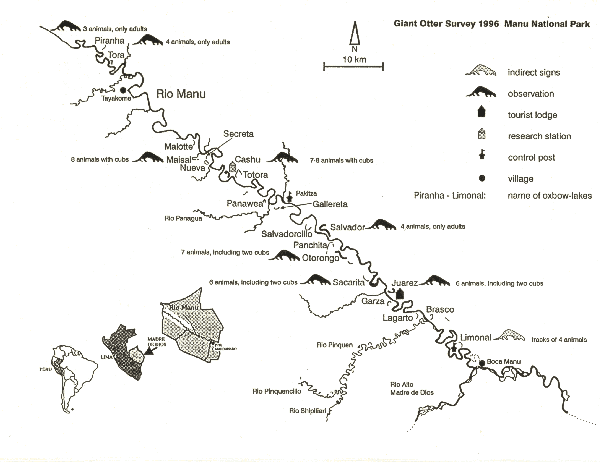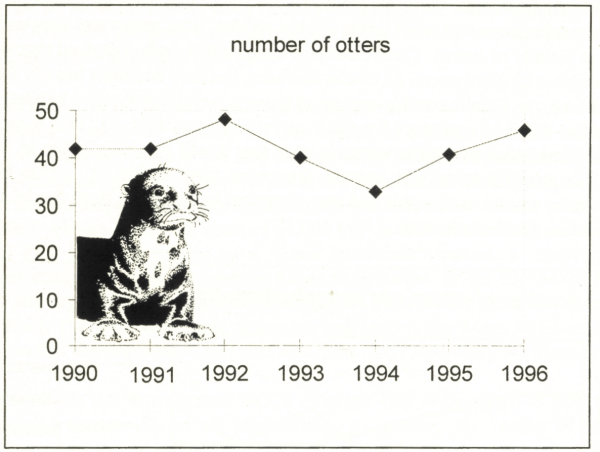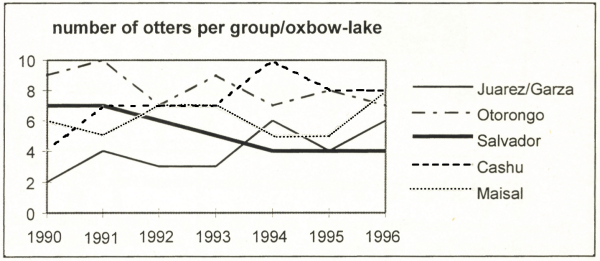 |
Last Update:
Thursday November 22, 2018
|
| [Home] |
Little was known about the ethology and ecology of the Giant Otter Pteronura brasiliensis, one of the most endangered inhabitants of the Amazon rain forest, when in 1990, we began our project "STATUS, HABITAT, AND CONSERVATION OF GIANT OTTERS IN PERU", with financial support from Frankfurt Zoological Society. After an initial intensive period of fieldwork in Peru from 1990 to 1992, the project has been continued by annual, two-months follow-ups in the field, while much of the project management, data analysis and public awareness activities is coordinated from our home-base in Germany. Here, we give a short progress report from 1996. We continued and further developed our giant otter conservation program. Major activities were to implement environmental education and public awareness measures, to conduct the annual otter census in Manu National Park, to evaluate various otter protection measures, and to improve cooperation with Peruvian nature protection authorities. In the following, we give short descriptions of the major project activities in 1996. Leaflet: Giant Otter - Neotropical River Otter When working at Rio Samiria, Departement Loreto, in the North of Peru in 1995, we found that the local population were poorly informed about the two sympatric otter species Pteronura brasiliensis and Lutra longicaudis. Even many park rangers were not able to tell the species apart. Due to this lack of information, it is hardly possible to obtain reliable reports on remnant populations. Furthermore, as a result of their unawareness of the species´ protection status, local people illegally kill otters or keep them as pets. To improve the situation, a leaflet was produced in cooperation with the Peruvian NGO ProNaturaleza, and our German partner Munich Wildlife Society. 2000 leaflets were distributed in the Departement Loreto in April 1996. Information board for Quisto Cocha Zoo A young giant otter female is kept at the Quisto Cocha Zoo outside Iquitos, the largest city in the lowland rainforest of Peru. We donated an information board on ecology, status, and conservation needs of giant otters. Drawing book for Peruvian children To address Peruvian children by the Giant Otter Project´s environmental education program, we are producing a drawing book, through which children shall discover and experience the tropical rainforest and its inhabitants. As an attractive and endangered species the giant otter is used as a flagship species: the booklet´s central character, a young otter named Pepe, is designed to deepen rural and urban children´s appreciation of their natural surroundings. The concept and layout were finished in 1996, production and distribution of the drawing book together with colour pencils are planned for the first half of 1997. The action is financially supported by a grant from the German Federal Ministry of the Environment via the German Technical aid agency, GTZ. Products in cooperation with other organizations The Dutch-British NGO “Upper Manu Expedition” in cooperation with the Manu National Park authorities produced a series of postcards on Manu in order to help financing park ranger salaries. We provided a giant otter photograph. Media.Com / Lima produced a CD-Rom on flora and fauna of the Manu National Park and the Tambopata-Candamo Reserve. The CD will be distributed for free among urban youngsters. We provided photographs on giant otters and other wildlife. Our 1994 TV-production in cooperation with Marco Polo Film, NDR, and Transtel/Deutsche Welle “The giant otters of Madre de Dios” is now available in serveral languages. Transtel provided a Spanish version for environmental education purposes in Peru, that we donated to several Peruvian NGOs. Public awareness activities Our activities to improve public awareness on rainforest issues in the developed countries included repeated broadcasting of our TV-production “The Giant Otters of Madre de Dios”, TV and print interviews, articles in magazines, a book production (Reader´s Digest), public lectures, poster presentations, etc. Field work in Peru We continued our giant otter monitoring program in Manu National Park during a work phase in Peru from September to November 1996. Our team consisted of project leader Christof Schenck, visiting scientist Dr. Ilse Storch of Munich Wildlife Society, and three Peruvian assistants. For the seventh year, we censused the 200 km of the Rio Manu upstream from its mouth (Fig. 1). The 1996 count resulted in 43 otters, indicating stable otter numbers since 1990 (Fig. 2). For the first time, we also censused the Manu 50 km further upstream, and found several den-sites and saw an otter group of three. Unlike further downstream, where otter groups are limited to the oxbow-lakes, in this remote part of the upper Manu otters live in the river permanently. A possible explanation is the absence of disturbing boat-traffic.
Also for the first time, we censused the lower 50 km of Rio Pinquen (see Fig. 1). The area is not used or visited by settlers or tourists, and belongs to the territory of uncontacted indian tribes. We were not able to find any signs of giant otters, but saw an individual of Lutra longicaudis. Due to greatly varying water-levels, low water in the dry season, great sediment load, and small size and number of oxbow-lakes, the Pinquen may not be an ideal giant otter habitat. We concluded that if at all, giant otters occur in very low numbers only. The census data contribute important details on the giant otter´s social structure, territoriality and range use behaviour, dispersal, and population dynamics. Using photography and video we documented the individual throat-patterns of 35 otters, 19 of which were already known from previous years. Several animals we have been following for 7 years by now, and are able to reconstruct their histories from cub age through dispersal and breeding. An example: "Punto", a female born at Cocha Otorongo in 1989, stayed with her native group until 1992, when she dispersed 13 km downstream to Cocha Sacarita. Here, she mated with "Pez", a native of Cocha Cashu, 66 km upstream of Cocha Sacarita. Since then the pair has inhabited Cocha Sacarita and produced a litter every year. The story of "Punto" and "Pez" is typical: Reproductive pairs keep their territories over several years. In contrast to dispersing young adult "solitarios", survival is high among territorial otter pairs. In 1996 we confirmed 10 parents aged six and older. In five of eight observed otter groups we found a total of at least 12 young of the year, i.e. a mean of 1.5 or more cubs per group. Group size and thus reproductive success differed among the study groups and over the years (Fig. 3). We suspect that tourism may have a negative influence on juvenile survival. Three lakes within Manu National Park are regularly visited by tourists. At two of them, Cocha Otorongo and Cocha Juarez, the otters successfully reared young in 1996. At Otorongo, we achieved that boat travel has been prohibited since1992. Juarez is still visited by tourist boats, but the resident otter group also uses undisturbed lakes in vicinity of Juarez. These examples indicate that well-organized tourism can be compatible with giant otters. At Cocha Salvador, the third and most heavily frequented tourist lake, the situation still is critical. Although they inhabit prime habitat, the otter group has failed to reproduce for three successive years (Fig. 3). This is most likely due to disturbance by tourist boats. In case that it will not be possible to limit boat travel to selected areas and prevent the otters from following tourist boats, we recommend to park authorities and tour operators to ban boats from the lake and use observation platforms instead.
The extreme shyness of the otters of Cocha Maisal indicated that this group is still being disturbed and possibly persecuted by the local Machiguenga settlers. Reasons for the persecution are not obvious and appearently our repeated and extended discussions with these settlers have remained without effect. We have no evidence for direct problems for giant otters caused by the indian village Tayakome, however, increasing contact to the outside world has started rapid development that is likely to lead to increasing conflicts with National Park policies. Observation Tower At Cocha Otorongo Canoe-trips on oxbow-lakes have been a major tourist attraction in order to observe giant otters and other fauna, and they cause significant disturbance and threats to giant otter groups, particularly during reproduction. As a less disturbing alternative we have suggested to erect obervation towers and platforms. In 1996, a 15 m high tower at Cocha Otorongo was completed. The tower was financed by Frankfurt Zoological Society and by the editors of the book "Peru´s Amazon Eden: Manu National Park and Biosphere Reserve", and has been well received by tourists and tour operators. Canoes are no longer allowed on lake Otorongo. MOBIL In Search Of Oil In Madre De Dios Department The company´s search for mineral oil has entered its second, intensive exploration phase, with major activities in the Rio de las Piedras and Rio Tambopata drainages. Oil exploitation perspectives played a role in the demarkation of the planned National Park in the Tambopata area. According to the latest revisions of the plans, major uninhabited primary rainforest areas of 14,000 km² in size will be excluded from the National Park and will remain as a "Zona Reservada" instead, a relatively poor protection status that does not exclude future exploitation. In the Rio de las Piedras area the last large virgin rainforests of southeastern Peru are the home of uncontacted indian tribes. The area lacks legal protection and borders the Manu National Park in the east, so that development in this area will most likely also affect the Manu area. Among Peruvian and international NGOs opinions vary with regard to how to face environmental threats due to oil exploitation. At present, the results of Mobil´s exploration phase should be awaited. We will remain in close contact with NGOs in Peru in order to coordinate further steps. Acknowlegdements: The project is financed by the Frankfurt Zoological Society, Help for threatened Wildlife and is carried out in cooperation with the Munich Wildlife Society. We like to Thank the Peruvian authorities INRENA and the administration of the Manu National Park for the possibility to realise the field work. Special thanks also to ProNaturaleza and ALITALIA for cooperation and support. REFERENCES Eisner, J., Sieber, J. (1993). unpublished Report: Fischotterkartierung an der Drau. |
| [Copyright © 2006 - 2050 IUCN/SSC OSG] | [Home] | [Contact Us] |


